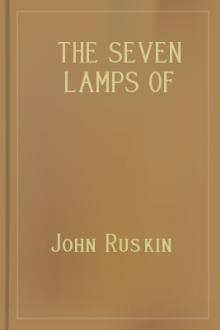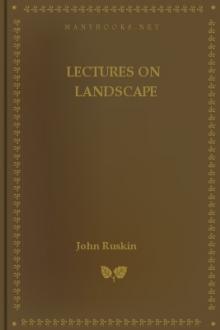The Seven Lamps of Architecture by John Ruskin (books like harry potter TXT) 📕

- Author: John Ruskin
- Performer: -
Book online «The Seven Lamps of Architecture by John Ruskin (books like harry potter TXT) 📕». Author John Ruskin
X. Nor is there, indeed, any present loss, in such respect, for futurity. Every human action gains in honor, in grace, in all true magnificence, by its regard to things that are to come. It is the far sight, the quiet and confident patience, that, above all other attributes, separate man from man, and near him to his Maker; and there is no action nor art, whose majesty we may not measure by this test. Therefore, when we build, let us think that we build for ever. Let it not be for present delight, nor for present use alone; let it be such work as our descendants will thank us for, and let us think, as we lay stone on stone, that a time is to come when those stones will be held sacred because our hands have touched them, and that men will say as they look upon the labor and wrought substance of them, "See! this our fathers did for us." For, indeed, the greatest glory of a building is not in its stones, or in its gold. Its glory is in its Age, and in that deep sense of voicefulness, of stern watching, of mysterious sympathy, nay, even of approval or condemnation, which we feel in walls that have long been washed by the passing waves of humanity. It is in their lasting witness against men, in their quiet contrast with the transitional character of all things, in the strength which, through the lapse of seasons and times, and the decline and birth of dynasties, and the changing of the face of the earth, and of the limits of the sea, maintains its sculptured shapeliness for a time insuperable, connects forgotten and following ages with each other, and half constitutes the identity, as it concentrates the sympathy, of nations; it is in that golden stain of time, that we are to look for the real light, and color, and preciousness of architecture; and it is not until a building has assumed this character, till it has been entrusted with the fame, and hallowed by the deeds of men, till its walls have been witnesses of suffering, and its pillars rise out of the shadows of death, that its existence, more lasting as it is than that of the natural objects of the world around it, can be gifted with even so much as these possess of language and of life.
XI. For that period, then, we must build; not, indeed, refusing to ourselves the delight of present completion, nor hesitating to follow such portions of character as may depend upon delicacy of execution to the highest perfection of which they are capable, even although we may know that in the course of years such details must perish; but taking care that for work of this kind we sacrifice no enduring quality, and that the building shall not depend for its impressiveness upon anything that is perishable. This would, indeed, be the law of good composition under any circumstances, the arrangement of the larger masses being always a matter of greater importance than the treatment of the smaller; but in architecture there is much in that very treatment which is skilful or otherwise in proportion to its just regard to the probable effects of time: and (which is still more to be considered) there is a beauty in those effects themselves, which nothing else can replace, and which it is our wisdom to consult and to desire. For though, hitherto, we have been speaking of the sentiment of age only, there is an actual beauty in the marks of it, such and so great as to have become not unfrequently the subject of especial choice among certain schools of art, and to have impressed upon those schools the character usually and loosely expressed by the term "picturesque." It is of some importance to our present purpose to determine the true meaning of this expression, as it is now generally used; for there is a principle to be developed from that use which, while it has occultly been the ground of much that is true and just in our judgment of art, has never been so far understood as to become definitely serviceable. Probably no word in the language (exclusive of theological expressions), has been the subject of so frequent or so prolonged dispute; yet none remained more vague in their acceptance, and it seems to me to be a matter of no small interest to investigate the essence of that idea which all feel, and (to appearance) with respect to similar things, and yet which every attempt to define has, as I believe, ended either in mere enumeration of the effects and objects to which the term has been attached, or else in attempts at abstraction more palpably nugatory than any which have disgraced metaphysical investigation on other subjects. A recent critic on Art, for instance, has gravely advanced the theory that the essence of the picturesque consists in the expression of "universal decay." It would be curious to see the result of an attempt to illustrate this idea of the picturesque, in a painting of dead flowers and decayed fruit, and equally curious to trace the steps of any reasoning which, on such a theory, should account for the picturesqueness of an ass colt as opposed to a horse foal. But there is much excuse for even the most utter failure in reasonings of this kind, since the subject is, indeed, one of the most obscure of all that may legitimately be submitted to human reason; and the idea is itself so varied in the minds of different men, according to their subjects of study, that no definition can be expected to embrace more than a certain number of its infinitely multiplied forms.
XII. That peculiar character, however, which separates the picturesque from the characters of subject belonging to the higher walks of art (and this is all that is necessary for our present purpose to define), may be shortly and decisively expressed. Picturesqueness, in this sense, is Parasitical Sublimity. Of course all sublimity, as well as all beauty, is, in the simple etymological sense, picturesque, that is to say, fit to become the subject of a picture; and all sublimity is, even in the peculiar sense which I am endeavoring to develope, picturesque, as opposed to beauty; that is to say, there is more picturesqueness in the subject of Michael Angelo than of Perugino, in proportion to the prevalence of the sublime element over the beautiful. But that character, of which the extreme pursuit is generally admitted to be degrading to art, is parasitical sublimity; i.e., a sublimity dependent on the accidents, or on the least essential characters, of the objects to which it belongs; and the picturesque is developed distinctively exactly in proportion to the distance from the centre of thought of those points of character in which the sublimity is found. Two ideas, therefore, are essential to picturesqueness,—the first, that of sublimity (for pure beauty is not picturesque at all, and becomes so only as the sublime element mixes with it), and the second, the subordinate or parasitical position of that sublimity. Of course, therefore, whatever characters of line or shade or expression are productive of sublimity, will become productive of picturesqueness; what these characters are I shall endeavor hereafter to show at length; but, among those which are generally acknowledged, I may name angular and broken lines, vigorous oppositions of light and shadow, and grave, deep, or boldly contrasted color; and all these are in a still higher degree effective, when, by resemblance or association, they remind us of objects on which a true and essential sublimity exists, as of rocks or mountains, or stormy clouds or waves. Now if these characters, or any others of a higher and more abstract sublimity, be found in the very heart and substance of what we contemplate, as the sublimity of Michael Angelo depends on the expression of mental character in his figures far more than even on the noble lines of their arrangement, the art which represents such characters cannot be properly called picturesque: but, if they be found in the accidental or external qualities, the distinctive picturesque will be the result.
XIII. Thus, in the treatment of the features of the human face by Francia or Angelico, the shadows are employed only to make the contours of the features thoroughly felt; and to those features themselves the mind of the observer is exclusively directed (that is to say, to the essential characters of the thing represented). All power and all sublimity rest on these; the shadows are used only for the sake of the features. On the contrary, by Rembrandt, Salvator, or Caravaggio, the features are used for the sake of the shadows; and the attention is directed, and the power of the painter addressed to characters of accidental light and shade cast across or around those features. In the case of Rembrandt there is often an essential sublimity in invention and expression besides, and always a high degree of it in the light and shade itself; but it is for the most part parasitical or engrafted sublimity as regards the subject of the painting, and, just so far, picturesque.
XIV. Again, in the management of the sculptures of the Parthenon, shadow is frequently employed as a dark field on which the forms are drawn. This is visibly the case in the metopes, and must have been nearly as much so in the pediment. But the use of that shadow is entirely to show the confines of the figures; and it is to their lines, and not to the shapes of the shadows behind them, that the art and the eye are addressed. The figures themselves





Comments (0)